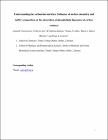| dc.contributor.author | Santos-Martinez, Maria | |
| dc.contributor.author | Colavita, Paula | |
| dc.date.accessioned | 2020-06-29T10:51:40Z | |
| dc.date.available | 2020-06-29T10:51:40Z | |
| dc.date.issued | 2020 | |
| dc.date.submitted | 2020 | en |
| dc.identifier.citation | Vasconcelos, J. M., Zen, F., Angione, M. D., Cullen, R. J., Santos-Martinez, M. J., Colavita, P. E., Understanding the Carbon-Bio Interface: Influence of Surface Chemistry and Buffer Composition on the Adsorption of Phospholipid Liposomes at Carbon Surfaces, ACS Applied Bio Materials, 2020, 3, 2, 997 - 1007 | en |
| dc.identifier.other | Y | |
| dc.identifier.uri | http://hdl.handle.net/2262/92866 | |
| dc.description | PUBLISHED | en |
| dc.description.abstract | Surface active phospholipids are present in fluids of biological relevance, and their adsorption may condition and determine the response of carbon and nanocarbon surfaces when they are immersed in physiological media. In this work, the adsorption and assembly of liposomes at carbon interfaces were investigated to understand the effect of surface termination on the extent and mode of assembly of lipid aggregates. Liposomes of natural lipids were prepared from a mixture of phosphatidylcholine(PC) and phosphatidylserine (PS), and their hydrodynamic size and surface zeta potential were studied as a function of pH.Adsorption was investigated at graphitic amorphous carbon surfaces (a-C) and at these surfaces after oxidative treatments (a-C:O).Infrared surface spectroscopy experiments show that PC/PS liposomes adsorb at a-C surfaces exclusively, independently of pH,while no adsorption is observed at a-C:O materials. Nanogravimetry and fluorescence imaging experiments in solution indicate that adsorption at a-C occurs as supported intact vesicles. Interestingly, PC/PS adsorption at oxidized surfaces was observed only in thepresence of a dication such as Ca2+, a behavior that was attributed to screening of surface−liposome repulsive electrostatic interactions. Vesicle rupture experiments show that lipids adsorb as monolayers on graphitic surfaces, whereas adsorbate structures correspond to bilayers in the case of oxidized carbons. These results therefore demonstrate a strong dependence of adsorbate structure on both carbon chemistry and buffer composition. These findings have important implications for the design of carbon nanoparticles, carbon electrodes, or carbon coatings for applications in biology and medicine. | en |
| dc.format.extent | 997 | en |
| dc.format.extent | 1007 | en |
| dc.language.iso | en | en |
| dc.relation.ispartofseries | ACS Applied Bio Materials.; | |
| dc.relation.ispartofseries | 3; | |
| dc.relation.ispartofseries | 2; | |
| dc.rights | Y | en |
| dc.subject | Amorphous carbon | en |
| dc.subject | Liposomes | en |
| dc.subject | Phosphatidylcholine | en |
| dc.subject | Phosphatidylserine | en |
| dc.subject | Supported bilayers | en |
| dc.subject | Vesicles | en |
| dc.subject | Oxidation | en |
| dc.title | Understanding the Carbon-Bio Interface: Influence of Surface Chemistry and Buffer Composition on the Adsorption of Phospholipid Liposomes at Carbon Surfaces | en |
| dc.type | Journal Article | en |
| dc.type.supercollection | scholarly_publications | en |
| dc.type.supercollection | refereed_publications | en |
| dc.identifier.peoplefinderurl | http://people.tcd.ie/santosmm | |
| dc.identifier.peoplefinderurl | http://people.tcd.ie/colavitp | |
| dc.identifier.rssinternalid | 217242 | |
| dc.identifier.doi | 10.1021/acsabm.9b01011 | |
| dc.rights.ecaccessrights | openAccess | |
| dc.subject.TCDTheme | Nanoscience & Materials | en |
| dc.subject.TCDTag | AMORPHOUS CARBON | en |
| dc.subject.TCDTag | CARBON | en |
| dc.subject.TCDTag | DIAMOND-LIKE CARBON | en |
| dc.subject.TCDTag | GRAPHITIC CARBON | en |
| dc.subject.TCDTag | LIPOSOMES | en |
| dc.subject.TCDTag | PHOSPHATIDYLCHOLINE LIPOSOMES | en |
| dc.subject.TCDTag | QCM-D | en |
| dc.identifier.rssuri | https://doi.org/10.1021/acsabm.9b01011 | |
| dc.identifier.orcid_id | 0000-0001-7038-5469 | |
| dc.status.accessible | N | en |
| dc.contributor.sponsor | Enterprise Ireland | en |
| dc.contributor.sponsorGrantNumber | CF/2012/2634 | en |
| dc.contributor.sponsor | Science Foundation Ireland (SFI) | en |
| dc.contributor.sponsorGrantNumber | 12/IP/1273 | en |




